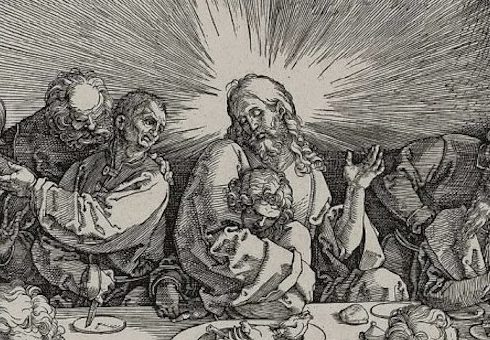Francis Martin and William M. Wright, IV, The Gospel of John. Catholic Commentary on Sacred Scripture. Grand Rapids: Baker Academic, 2015.
The Second Vatican Council called for greater access to the Scriptures for all the faithful (Dei Verbum 22), insisting that Scripture should be “the very soul of sacred theology” (DV 24). Despite this exhortation and others like it, for many years there was a dearth of resources that not only explained the Scriptures, but also helped readers apply them to their lives. Many commentaries focused on technical details almost to the exclusion of theological questions, to say nothing of the Church’s tradition and the spiritual life. The Catholic Commentary on Sacred Scripture, a series published by Baker Academic Press, seeks to fill this gap. The current volume by Francis Martin and William Wright lives up to the standard set by other commentaries in the series (see Dominicana 58.2 for a review of the volume on the Book of Revelation).
Known since the early days of the Church as the “spiritual gospel,” the Gospel of John has fed the spiritual lives of believers through the centuries, as well as played a central role in the development of the Church’s understanding of the Trinity. Martin and Wright draw on both of these traditions in their exposition of the text, while at the same time engaging the best of modern scholarship. The result is a sound reading of this simple yet profound gospel that manages to bridge the seemingly unbridgeable gap between the first century and ours. Without simply conflating the meaning of the text with later Church teaching, Martin and Wright demonstrate the organic continuity between the two. The commentary frequently cites passages from the Catechism of the Catholic Church that expound on theological ideas the seeds of which are to be found in John, as well as pointing out the central role the text played in early theological debates.
One of the most profound themes that arises again and again is the “eternal exchange of love” that constitutes the inner life of God (24 et passim). This phrase, taken from CCC 221, nicely sums up one of the central teachings of John. By both his words and his deeds Jesus reveals the self-giving nature of divine love. Thus Martin and Wright comment on Jesus’ discussion with his opponents in John 5, “Everything about the Son—his life, words, deeds—comes from the Father” (106). The Father gives himself completely to the Son, and the Son in turn gives himself completely for the sake of the sheep (Jn 10:11). This gift of the Father, mirrored perfectly by gift of the Son, points to the purpose of Christ’s incarnation, death, and resurrection, namely that we might be taken up into that eternal communion: “The Father offers an infinity of life and love to humanity through Jesus” (191). All of Jesus’ teaching and action is oriented to leading us to participate in that abundant life (Jn 10:10).
In addition to showing the profound theological riches of the Gospel, Martin and Wright also deftly draw out its implications for the spiritual life based on fine literary analysis. Among the more prominent features of John’s literary style are double meaning and lengthy dialogues between Jesus and other figures in the story (e.g., Nicodemus, the Samaritan woman, the man born blind). Often in these dialogues a person comes to Jesus (or is approached by him) with an inadequate understanding of who Jesus is, but with the desire to learn more. Jesus then gradually leads them to a deeper understanding and, ultimately, a profession of faith in him. Thus John provides a variety of images for the life of discipleship, which often begins only incipiently and must grow over the course of a lifetime.
Each volume in the Catholic Commentary on Sacred Scripture also features numerous sidebars offering additional information regarding the biblical background of the text or drawing connections with the Church’s tradition. These sidebars help break up the monotony of a standard commentary and offer insightful treatments of sometimes challenging topics. For example, one of the more difficult aspects of the Gospel of John is its constant reference to “the Jews,” oftentimes with harsh connotations. Drawing both on the literary characteristics of the Gospel and its historical setting, Martin and Wright offer a nuanced discussion of the term, noting the contexts in which it is used positively and (rightly) suggesting that the negative uses of the moniker typically refer to the Jewish authorities in Jerusalem intent on killing Jesus.The “Living Tradition” sidebars seek to meet the call of Dei Verbum to combine historical study of the Bible with the whole of the Christian tradition. These sidebars draw on important spiritual writers from practically every period of the Church’s history, from Ignatius of Antioch and Origen in the early centuries to Popes Benedict XVI and Francis in our own, as well as treasures of the Church’s hymnic tradition such as “O Come, O Come, Emmanuel” and St. Thomas Aquinas’ Adoro Te Devote. Connecting the Gospel with such resources encourages and aids the reader in seeing how the Gospel can feed the spiritual life. At the same time, it reminds us that the Church’s tradition ultimately is nothing other than her exposition and application of the life of Christ as first presented in the writings of the New Testament. So, for example, in one of these sections Martin and Wright suggest that the tradition of the Sacred Heart of Jesus is rooted in the love and affection Jesus shows for his friends, particularly his sorrow at the death of Lazarus and the mourning of his sisters Mary and Martha (208).
Several other features make this a useful commentary. The authors present a clear discussion of the most important background issues to the gospel, particularly its authorship and historical setting, as well as highlighting some of its more prominent literary features. Their outline of the gospel gives the reader a reliable bird’s-eye view of the text. Although the introduction discusses the basic structure of the gospel, it might have been helpful had the outline delineated this structure more clearly, but this is a minor quibble. A glossary defines key terms, which are clearly marked throughout the commentary.
All in all, Martin and Wright’s volume is a welcome addition to this series. Those looking to dive a little deeper into Scripture and to see its connection with the Church’s living tradition will benefit from this accessible overview of the Gospel of John.
✠
Image: Albrecht Dürer, Last Supper
To download a printable PDF of this Article from
Dominicana Journal, Winter 2016, Vol. LIX, No. 2, CLICK HERE.




